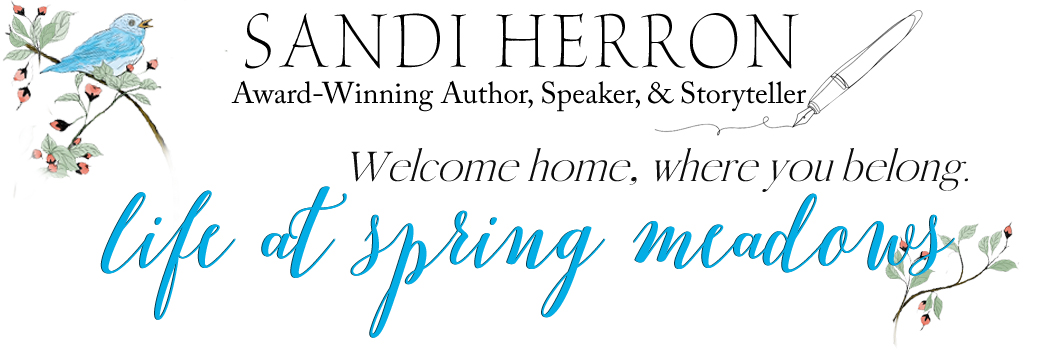Displayed throughout my house are handmade quilts passed down from my family and my husband’s family. It never fails that the scraps of fabric used to create the handmade quilts bring many memories to mind. Some quilts have intricate designs, but most are simple scrap quilts. They are my favorite for several reasons, but one is that the scrap quilts tell a story through each piece of fabric used to create a beautiful work of art.



The blizzard that hit Alabama in March 1993, also known as The Storm of the Century, surprised us all. But as we always do when there is even the slightest threat of snow, we stood in line at the grocery store and purchased our bread, milk, and eggs to prepare for a few days of being shut in. As the snow began falling on March 12, I grabbed a quilt and curled up on the sofa by the fire. I chose my favorite quilt, a soft patchwork design my mother made many years ago from fabric left from her sewing projects. She pieced together the colorful fabric scraps into twelve-inch blocks, then sewed the blocks in rows to create one large piece called the quilt top.
As I snuggled beneath the quilt to stay warm, I noticed a block made with scraps from one of my favorite dresses—a blue and white polka-dotted dress I wore on the first day of the new school year when I was seven.
Growing up, I never knew what it was like to go shopping for new clothes. Instead of having store-bought garments, almost everything we wore was handmade. I felt fortunate to have such a talented mother. If I could dream it, she could make it. Her inspiration for clothing designs often came from the window showcases of department stores.
As I ran my hand over the pieces of fabric, I vividly remember standing by my mother’s side in front of a department store in downtown Bessemer, Alabama.
Stepping Back in Time
It was late August, just a few days before the start of the new school year. The blistering southern heat intensified while we shopped for school supplies. With sweat running down my face, I was eager to return home, cooling on the porch underneath the ceiling fan while reading my new Trixie Belden book I bought at McLellan’s Five and Dime with my weekly allowance of twenty-five cents.
As we walked down the sidewalk, heading to our car, a display in the window of Sokol’s department store caught our attention. Mama turned and stopped in front of the window. I stood by her side as we admired a blue and white polka-dotted dress that seemed just my size. There was a twinkle in Mama’s green eyes as she turned her head from side to side, and l knew that the wheels were turning in her creative mind. She opened her purse, scrambled through tubes of lipstick, compact powder, used envelopes with a recipe or grocery list written on them, and finally found what she was looking for—a scrap of paper and a little stubby pencil. Then, using her purse for support, she created a rough sketch of the dress.
When she completed her drawing with all the details, we walked down the street and around the corner to the fabric store. We searched through bolts of fabric until she found a material that matched the dress in the window. A few days later, on the first day of the school year, I proudly wore what my mother had made. However, my dress included details the one we saw in the window lacked.
I enjoy these unforgettable memories while curled up by a fire and snuggled under a quilt made long ago. But it is extra special when I recall how everything my mother did, she did with love, like making a dress or piecing a quilt that would last for years to come.
How Did Mama Make the Quilt?
My mother and grandmother made quilts to fit full-size beds, which was the most common before king-size beds became popular.
To make the quilt, they cut fabric scraps into squares, then pieced them together to create twelve-inch blocks. For a full-size quilt, they needed thirty blocks. Once completed, they sewed the blocks in rows with a strip of fabric in between. The strip, called “sashing,” usually contrasted the blocks. The blocks and strips made a beautiful quilt top when sewn together. Next, they sandwiched the top with cotton batting and a backing. Then, using a quilt frame to hold the layers together, they finished the quilt with tiny, even stitches sewn through all the layers.
Needles, thread, and a thimble were essential tools used in quilting. I have a keepsake box with thimbles used by my ancestors.
In today’s world, some quilters use long-arm quilting machines (what is that?), while others use a home sewing machine designed to handle the quilt’s heavy fabrics and layers.
The quilts my mother and grandmother made were all sewn by hand. They used a quilting frame suspended from the ceiling. Another option they did most often was placing the frame on sawhorses (what is a sawhorse?). My grandfather brought the sawhorses in from the barn after he cleaned them and then used clamps to hold the quilting frame in place.
If building a quilting frame interests you, I discovered this YouTube video showing a brilliant DIY frame design.
Another tutorial I like is this YouTube video that shows how to do hand quilting.
Some of my fondest memories are days spent with my mother and grandmother as I watched them quilt while I played with my doll in a make-believe world underneath the quilting frame.
Thankful for the life my mother gave me, a life pieced together one day at a time with love.
